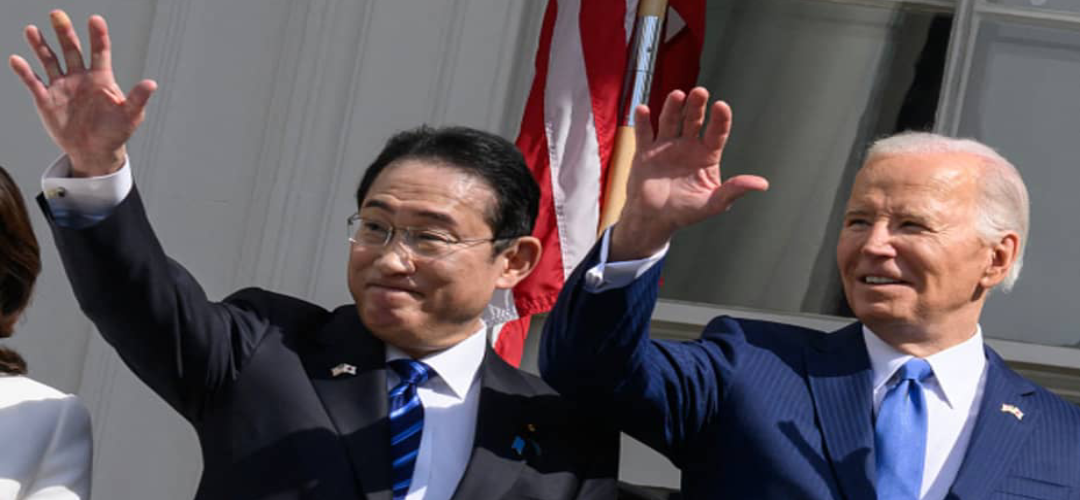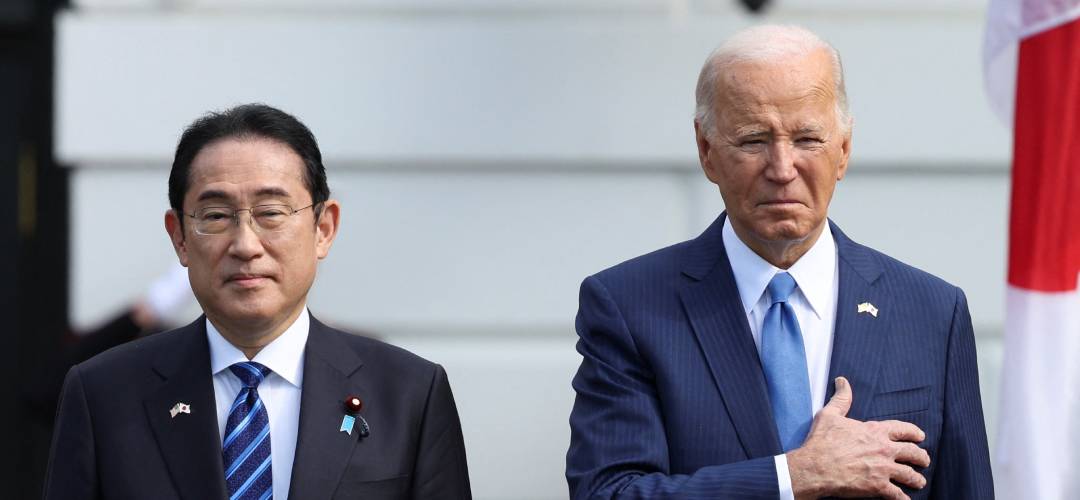The U.S. Ties With the Far East
April 20, 2024 | Expert Insights

The U.S.’s Deal with Japan
The U.S. and Japan have entered a new military era of cooperation intended to counter China’s influences in the Far East, setting a new benchmark for bilateral military cooperation. U.S. President Joe Biden and Japanese Prime Minister Fumio Kishida visited the White House on Wednesday to affirm a new joint command structure of cooperation in addition to Australia to increase seamless interoperability between the militaries. The crux of their bilateral defence and security cooperation is the Treaty of Mutual Cooperation and Security, or the U.S.-Japan Security Treaty, or Anpo jōyaku in Japanese. The treaty, signed in Washington D.C on 19 January 1960, authorises the U.S. military presence on Japanese soil and binds both nations to support one another, especially if the U.S. is attacked in territories under Japanese administration. The treaty reaffirmed U.S. unwavering commitments to Japan’s defence in the late 1990s and, it serves as the backbone of peace, security and freedom in the Indo-Pacific region.
This new era of bilateral partnership between the two marks the most significant revision of the alliance since its establishment. Japanese PM Kishida is the first Japanese leader, and the fifth world leader to receive a state visit invitation since Biden took office in 2021. The last state visit to the U.S. was in 2015 by former PM Shinzo Abe. After a series of changes in security law in the past decade, Japan’s role has transformed its pacifist constitution into a more predominant global role. The U.S. announces that for the first time, it is working on developing a new networked architecture system for air, missiles and defence with Japan and Australia. In addition, they are looking at plausible trilateral military exercises with Japan and the U.K., and possible cooperation between Japan and the U.S.’s Aukus (U.S., U.K. and Australia) defence partnership concerning advanced capabilities and technologies (quantum computing, undersea hypersonic technology, artificial intelligence and cyber technology). Biden identified that their top foreign investor is Japan, and both national leaders publicised deals for artificial intelligence and joint partnerships to propel nuclear fusion development and commercialisation. The agreement is the biggest development since the 1960s as about 70 agreements between the two, including an initiative to improve Japan’s U.S. military command structure.
“As I often say, Ukraine of today may be East Asia of tomorrow”, PM Kishida addressed Congress on 11 April 2024 where connected support for Ukraine in the Russia-Ukraine war as crucial to deterring China’s aggression in Taiwan and triggering another war, this time in East Asia. Jointly with President Biden and Phillippines President Ferdinand Marcos Jr, the leaders focused on Beijing’s incursions in the South China Sea. Forums for the co-development and co-production of missiles and maintenance of US warships and aircraft, fighter pilots and jet trainers will be set up by both sides. The play appears to bolster the agility of the U.S. and Japanese forces in the event of a conflict in the region, as Biden insists it is “purely defensive” and “not aimed at any one nation or threat to the region”. The partnership claims to be focused on augmenting the free and open rule of international law and order which has allowed numerous nations to develop in sovereignty.

The U.S.’s closure relationship with the Philippines
President Joseph R. Biden welcomed Philippine President Ferdinand R. Marcos Jr. back to the White House. The two Presidents highlighted the exceptional strength of the US-Philippines Alliance and the historic progress made in bilateral ties since their last meeting at the White House in May 2023. Presidents Biden and Marcos aim to continue making significant contributions to our two countries' strong relationship.
The United States and the Philippines are working together to foster equitable economic growth in both nations, especially through the Indo-Pacific Economic Framework for Prosperity (IPEF), which will be launched in 2022. Japan, the Philippines, and the United States unveiled the Luzon Economic Corridor, the first Partnership for Global Infrastructure and Investment (PGI) corridor in the Indo-Pacific. The corridor will connect Subic Bay, Clark, Manila, and Batangas in the Philippines. Japan, the Philippines, and the United States have agreed to accelerate coordinated investments in high-impact infrastructure projects such as rail, port modernization, clean energy and semiconductor supply chains and deployments, agribusiness, and civilian port upgrades at Subic Bay through this corridor, which is part of the PGI-IPEF Investment Accelerator.
Over the last year, the United States Trade and Development Agency (USTDA) has announced new initiatives that would leverage more than $500 million from the public and private sectors to build high-quality infrastructure in the Philippines. These initiatives promote renewable energy, smart grids, vessel traffic management system upgrades, customs and supply chain modernization, healthcare solutions, and aviation infrastructure. To support present and future activities, USTDA will establish a new office at the US Embassy in Manila in early 2024.
The United States International Development Finance Corporation (DFC) is devoted to promoting private sector investment in the Philippines, particularly in key sectors such as infrastructure, essential minerals, and renewable energy. DFC is pleased to announce a fresh $20 million loan to promote affordable housing throughout the Philippines, increasing the total commitment to $80 million. DFC also plans to establish a regional office in the Philippines to facilitate additional investment around the country.
Analysis
The joint vision statement from the leaders of Japan, the Philippines, and the United States highlights their commitment to a free and open Indo-Pacific region. They emphasize historical ties, economic relations, and shared values of freedom, democracy, human rights, and the rule of law. The leaders pledge to work together to advance security and prosperity in the region and uphold international law.
The statement underscores the importance of democratic values, human rights, and gender equality in strengthening bilateral relationships and the trilateral partnership. It acknowledges the leading role of women in peace processes and the upcoming International Conference on Women, Peace, and Security in the Philippines. The commitment to safeguarding human rights, media freedom, and labour rights is a cornerstone of the partnership.
Regarding regional security, the statement expresses concerns about China's behaviour in the South China Sea, including militarization and maritime claims. It opposes coercive actions and disruptions to offshore resource exploitation. The leaders reaffirmed their commitment to freedom of navigation and respect for international law, particularly the United Nations Convention on the Law of the Sea (UNCLOS).
The leaders also address the situation in the East China Sea, opposing any unilateral attempts to change the status quo through force or coercion. They support Japan's administration of the Senkaku Islands and call for adherence to international law. Additionally, the document condemns the DPRK's escalatory threats and missile launches, emphasizing the need to address human rights concerns and comply with UN Security Council resolutions.
In terms of economic cooperation, the leaders plan to expand investments in infrastructure projects, clean energy, semiconductor supply chains, and agribusiness. They aim to attract transformative investments through partnerships with multilateral organizations and the private sector. The establishment of a regional office by the U.S. International Development Finance Corporation in the Philippines demonstrates a commitment to enhancing economic cooperation.
On defence cooperation, the nations intend to conduct joint maritime exercises to improve interoperability and maritime security. They emphasize the importance of maritime domain awareness and humanitarian assistance in addressing transnational threats. The commitment to providing maritime law enforcement training to partner countries underscores a shared goal of promoting regional security and stability.
In conclusion, the joint vision statement reflects a comprehensive approach to advancing shared interests in the Indo-Pacific region. It underscores the importance of democratic values, human rights, and gender equality while addressing regional security challenges and promoting economic growth. The commitment to cooperation in defence and maritime domains highlights a collective effort to enhance security and stability in the region.
Assessment
- The partnerships between Japan, the Philippines, and the United States appear to be robust and well-coordinated, as evidenced by their joint vision statement and commitments outlined in the document.
- The leaders emphasise historical ties, shared values, and a commitment to a free and open Indo-Pacific region, indicating a strong foundation for collaboration.
- The focus on economic cooperation, defence initiatives, regional security, and maritime activities demonstrates a comprehensive approach to addressing common challenges and advancing shared interests. Overall, the partnerships seem to be structured to promote long-term stability, security, and prosperity in the region.








Comments